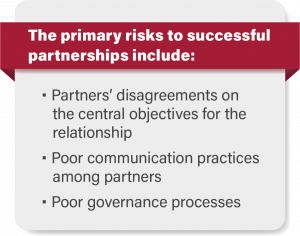 By Brendan O’Meara, TCG Partner Engagement Manager
By Brendan O’Meara, TCG Partner Engagement Manager
Shared services establish “partnerships” with customers, in recognition that the service exists to serve customers’ needs and will be improved in concert with customers’ evolving requirements. So partnerships are foundational to every Shared Service Provider’s (SSP) success. Rigorous outreach and vetting of agencies’ suitability for such strategic partnerships is arguably more crucial than the SSP’s marketing or sales. According to a survey of 1,250 executives by McKinsey, the primary risks to successful partnerships include:
- partners’ disagreements on the central objectives for the relationship;
- poor communication practices among partners; and
- poor governance processes.
While strategic partnerships in the private sector are different in many ways, these same risks are present within the federal government shared services environment. Mitigating these risks and establishing shared service partnerships can be especially challenging because the shared service model is not the norm in the federal government. Avoiding confusion, establishing clear lines of communication, and detailing governance processes begins immediately with partner outreach and proactive risk management. Here are three keys to successful partner outreach and vetting.
1. Comprehend the potential partner’s business goals
Potential partners often fall into two buckets: (a) those that are looking for a solution to an immediate problem in a cost effective way, and (b) those that are looking to make a longer term investment because they understand and want to leverage the value of the shared service model beyond a specific tool or technology.
While organizations in either category can make good partners for a service offering, the second group is looking for more substantive, longer term relationships that are mutually beneficial to all parties. Developing these relationships can take more time, especially because they are exploratory and are unlikely to have secured, dedicated funding prior to the start of the vetting process. Eventually, these organizations can become the best partners because they take time to learn about the platform, understand that it is completely self-sustaining, and negotiate and operate from a position of greater strategic alignment with the SSP.
SSPs need to clearly define the different types of service levels they offer, which may range from “plug and play” solutions to custom-built products. These service levels likely have different support from a shared help desk to a designated support contact. Regardless, matching the right service level to an organization’s needs and communicating clearly about what is included at each level is essential for a successful partnership.
2. Take on projects that make sense for the service community
Any SSP needs to understand that their offering may not be the right fit for every agency or organization. (This is not a condemnation of the offering. Apple and Samsung both make great phones, and they fit different users for different reasons.) This is particularly true when the service is centered on a technological capability such as data collection or reporting as opposed to a back office function such as payroll. A general capability can be used for a number of different functions that may fill back office or mission-focused needs, so there is a wider range of contexts in which a tool can be deployed. With a wider context, finding the right tool for the job becomes more challenging. Potential partners may need a commercial solution, custom development, or another shared service. Taking on projects for which a service is ill-suited can be costly in the long run. Organizations need to ensure that they are entering an “actual partnership” where both parties are benefiting. Any custom development that is required to support the partnership, for example, should ultimately benefit the entire community.
3. Carefully assess partners’ requirements and the gaps they are looking to fill
Many potential partners have a very good sense of their requirements but others may not always understand what their own requirements are or how specific gaps should be filled. During partner outreach, SSPs can offer objective perspectives on a potential partner’s requirements and gaps. This is an area where partner outreach becomes a value added service, as it assists potential partners in understanding what they need and whether the service offering will be a good fit for all parties.
Organizations thinking about offering a shared service need to balance requirements of individual partners with the requirements of the overall service community, and this means working with potential partners to ensure that the service offering is the best approach to address their needs.
In an article for CIO, Brendan McGowan and Xiao-Fei Zhang note that IT buyers often look for vendors willing to become transparent and trusted collaborators. Failure in establishing these relationships has serious consequences. “Ultimately, buyers are accountable to their internal stakeholders across their respective organizations. Failure to execute on strategic partnerships represents a potential failure to execute on business objectives, with attendant professional and financial risks.” The same dynamic exists in shared services in the federal government, regardless of the level of service that is needed. Poor partner relationships can lead to challenges in mission delivery, which in turn means failure in providing value to the American taxpayer. Thorough partner outreach and vetting is essential in establishing strong relationships for a community of users that is designed to grow, and thereby provide better services as the offering is scaled up. While scaling has its own challenges, which we discuss elsewhere, understanding potential partners and being transparent at the very beginning of outreach is essential for long-term success.
Brendan O’Meara is the Partner Engagement Manager for MAX Shared Services. He has been working with MAX for six years now and is responsible for managing the relationships, finances and outreach for the entire MAX program.